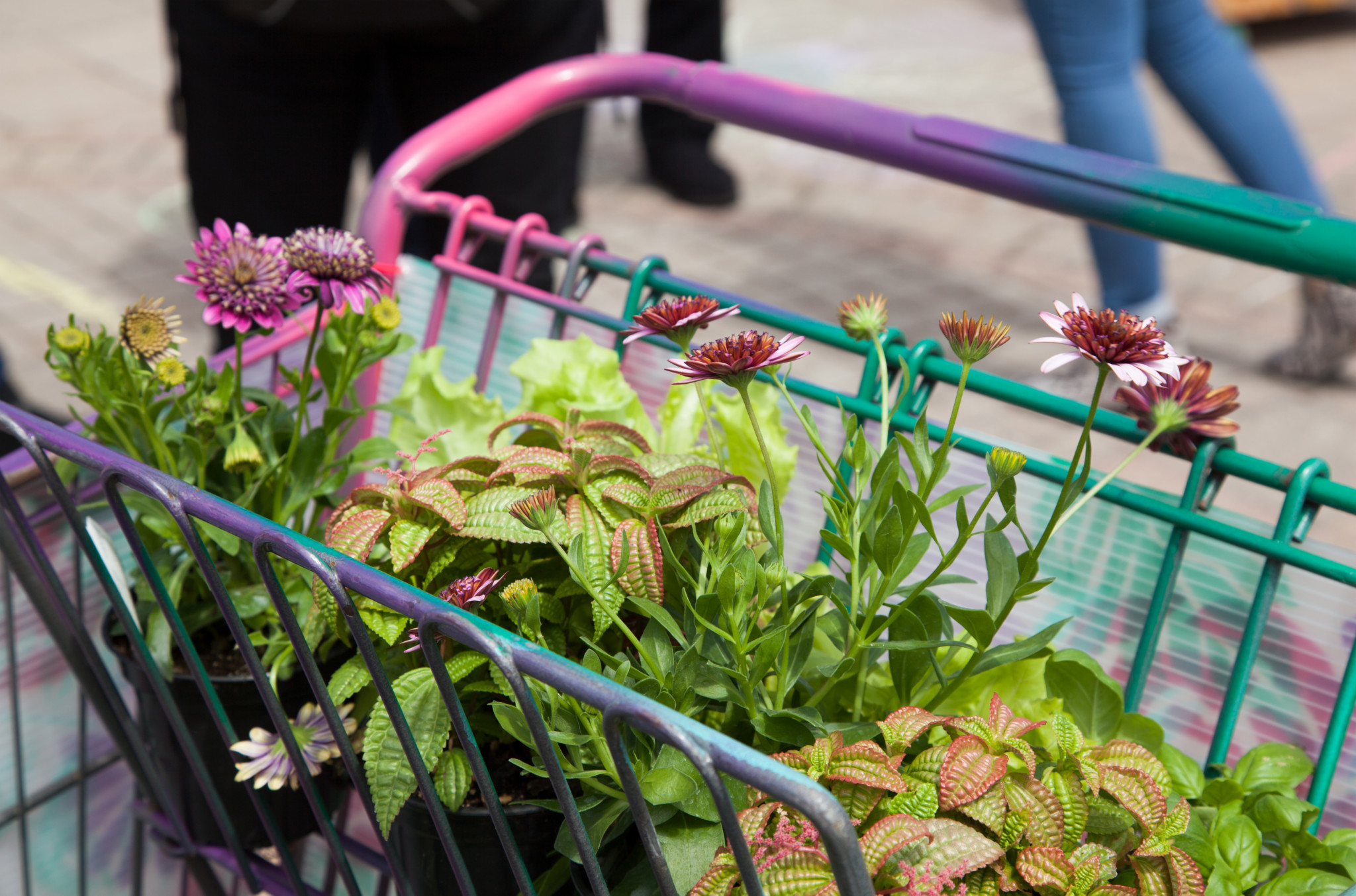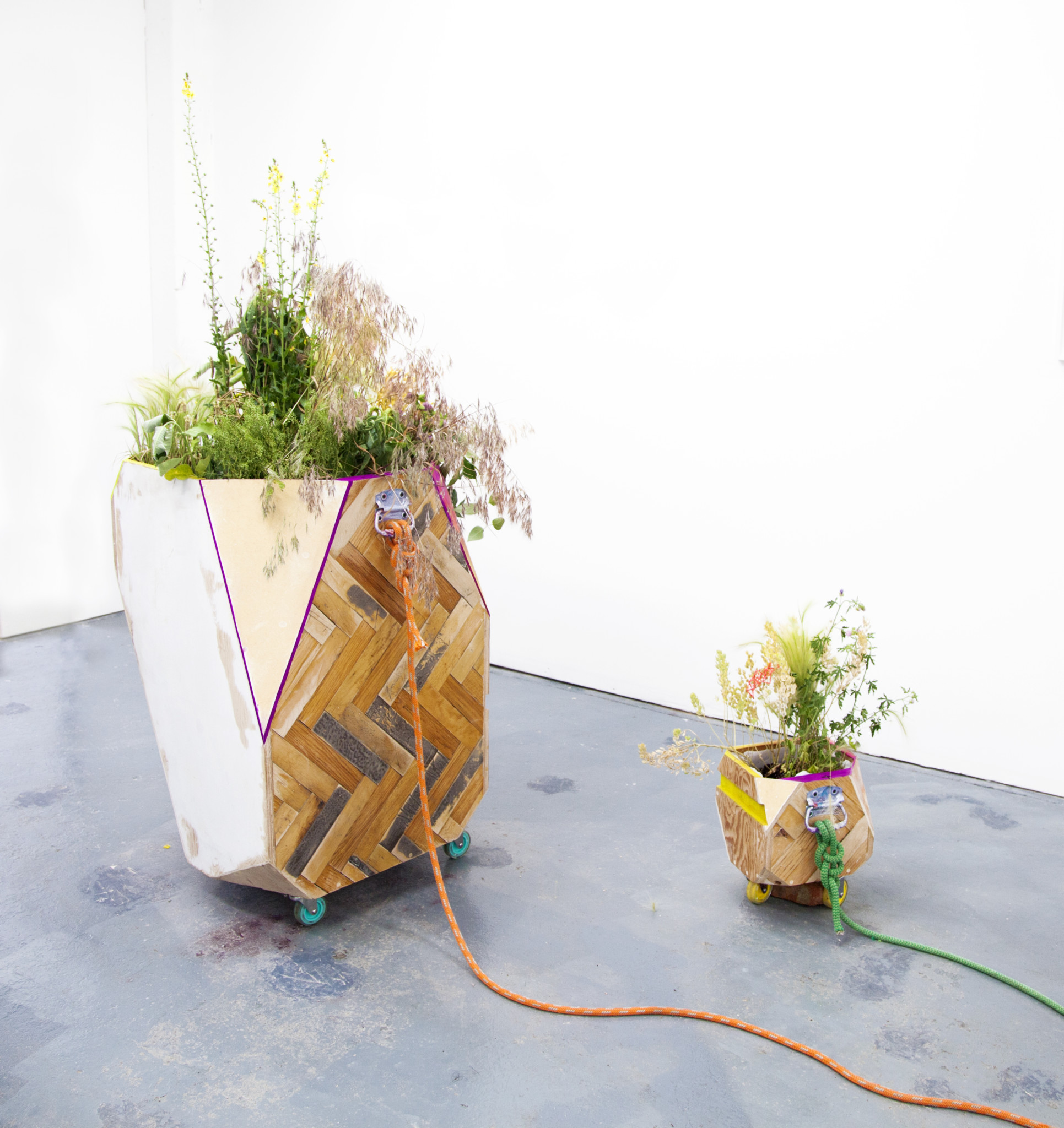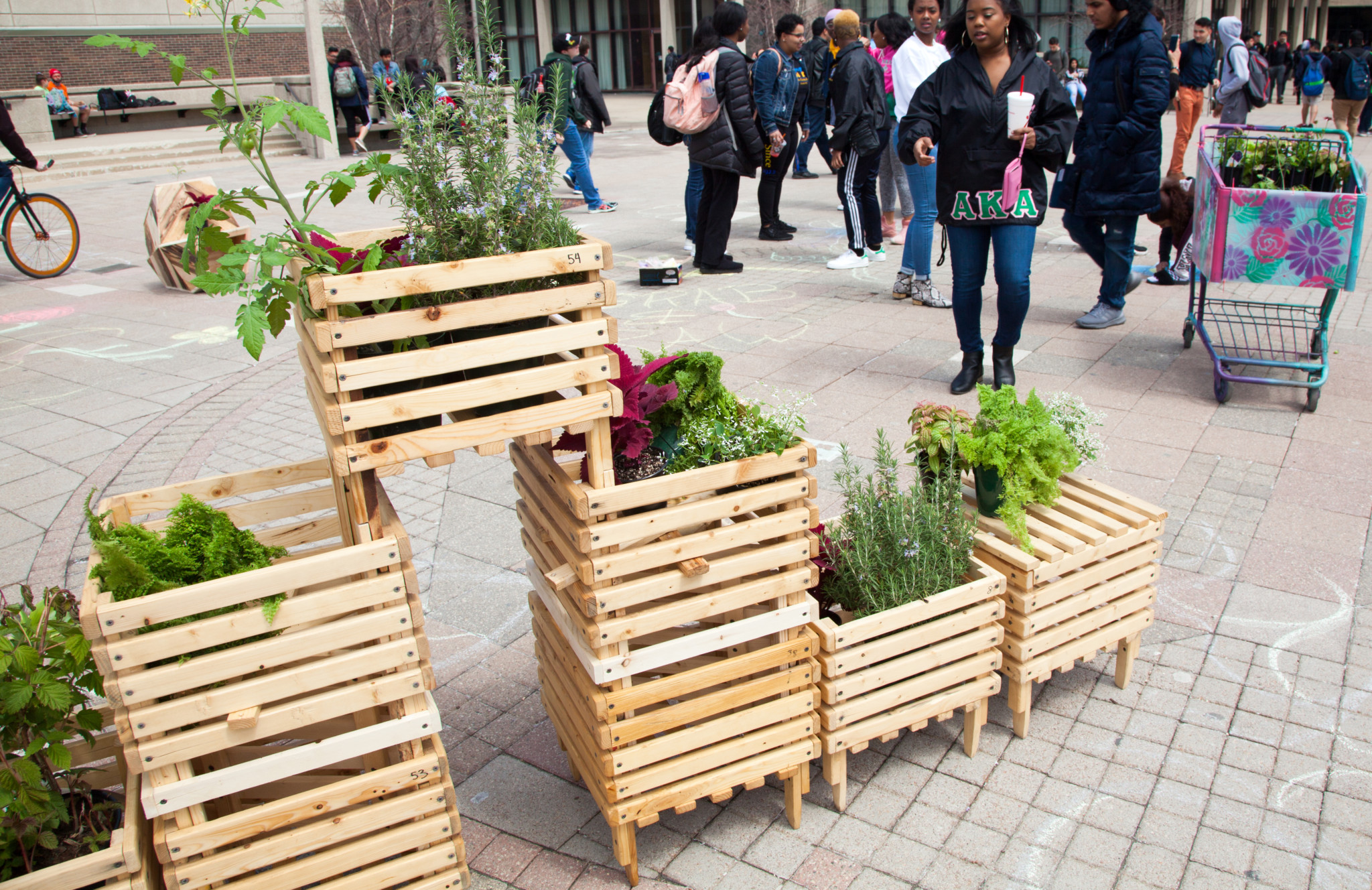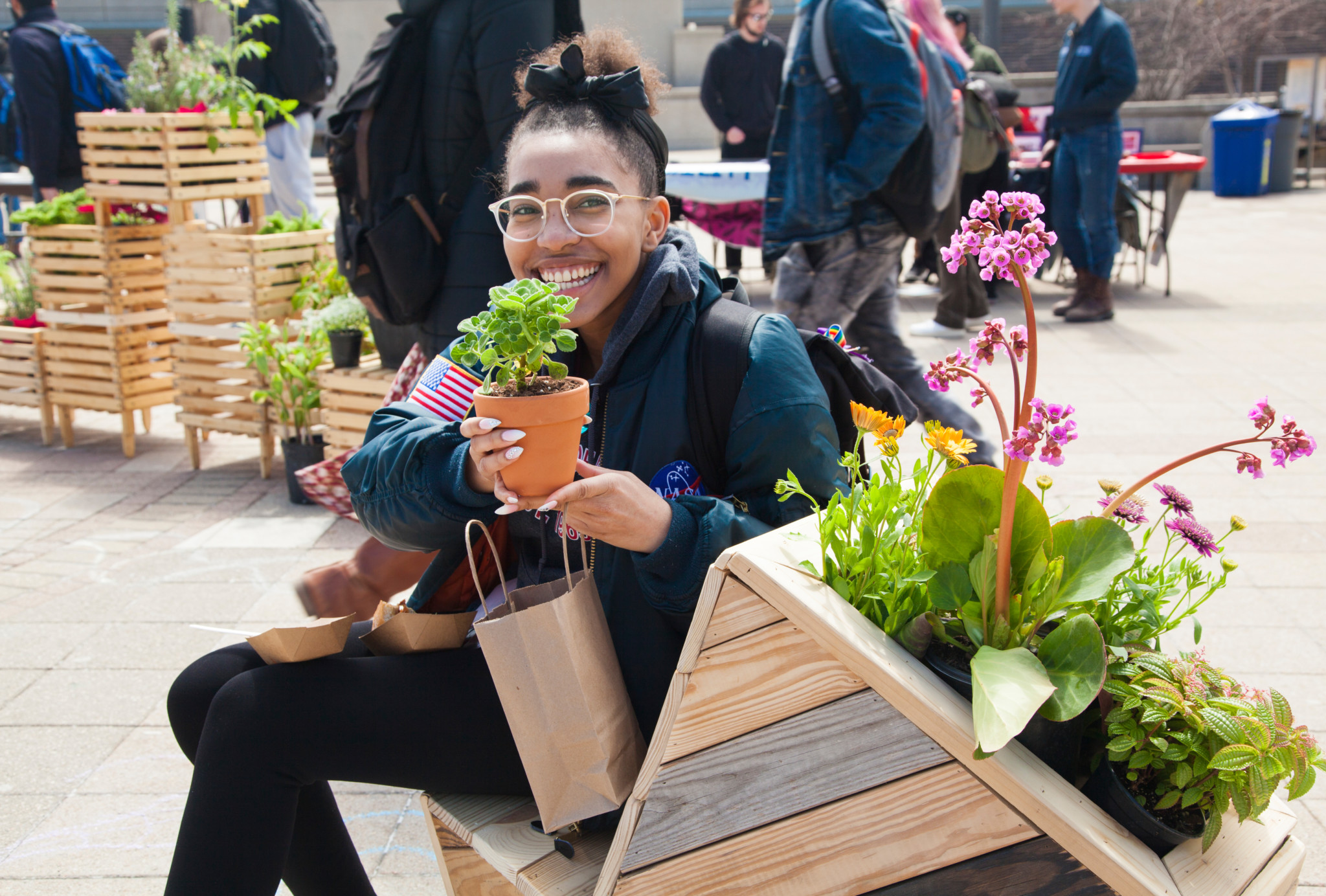Garden for a Changing Climate,” the traveling public art project by artist Jenny Kendler, has grown as organically as one of its mobile planters.
Run in partnership by Kendler and Gallery 400, an art gallery run out of the University of Illinois at Chicago (UIC), “Garden for a Changing Climate” comprises lush and vibrant local plants growing in and spilling out of decorative wooden planters. The project features in community events within the neighborhoods it visits throughout the summer, including Marshall Square, West Garfield Park, and Washington Park. The artists tailor the plants and planters, and the medium through which they’re exhibited, to reflect the particular climate change issues that each neighborhood faces.
The project was initiated by Lorelei Stewart, the director of Gallery 400. Having worked with Kendler before, Stewart reached out to work together on a Humanities Without Walls grant run by the Andrew Mellon Foundation. Kendler, an interdisciplinary artist whose work focuses on climate change and humanity’s relationship with the natural world, said that she had already been considering a project with mobile planters. Her original concept was for the planters to move during the exhibit, representing the movement of plants over a longer period of time.
Kendler explained that as the planet warms, ecozones shift north: “If you have a plant that’s adapted to a certain climatic band, in order for it to survive, it would have to reseed or re-root northerly to stay in the same climate band.” The effects of this process seem slight from an everyday human perspective; the moving planters convey the preceptible impact of that change.
While Chicago may be isolated from some natural disasters caused by shifting ecozones, Kendler said, “a lot of these things are going to affect us in different ways. We’re certainly going to see agricultural zones that were once fertile become less fertile. We’re definitely going to see drought. We’re going to see flooding.” The art project engages many of these issues directly. At its exhibit in Marshall Square, for example, residents will walk from one school to another to act out the shift of ecozones. Additionally, in response to urban impacts of the shifting ecozones, and in partnership with the Metropolitan Water Reclamation District, the artists will give out oak saplings for people to plant to reduce flooding and bring down the heat index.
As Kendler discussed her concept with Stewart, her moving planters idea melded with Gallery 400’s ongoing mission of bringing together community partners to create art oriented around social change.

“I always like to think that UIC reflects Chicago, or should be reflective of Chicago, and that we, as a part of [UIC], in our exhibitions need to do that,” Stewart explained. “Our exhibitions are going to be increasingly about what community partners need and how we can build projects together.”
This mission is particularly important in the context of UIC’s geographic history. UIC lies in Little Italy, and its construction in 1963 caused the demolition of parts of the neighborhood, displacing thousands of residents. Since then, organizations in adjacent neighborhoods, such as the Eighteenth Street Development Corporation in Pilsen, have opposed land purchases made by UIC. Its 1998 expansion, which developed thirty acres south of UIC, stopped short of Pilsen at 15th Street but was still seen as an encroachment on the community.
Marcela Torres, the Community Engagement and Public Programs Manager at Gallery 400, said that the art project is also part of a broader conversation to explore “how in future shows we pair artists with communities, and the communities that they want to work with.” A few years ago, Gallery 400’s work with neighborhood groups on its Standard of Living project brought up social issues in Chicago, such as food deserts and police violence. However, Stewart said, “a big thing was the dislocation between neighborhoods.” Garden 400, therefore, is now making efforts to “bring people from different neighborhoods together.”
The community engagement model has been at the heart of “Garden for a Changing Climate,” with the artists refining and adapting the mobile planters to fit the goals of each neighborhood organization they collaborate with.
Heather Miller, executive director of the American Indian Center (AIC), said that the AIC’s involvement arose naturally from working closely with Gallery 400 in the past. The AIC, located in Albany Park, was originally founded to support American Indians moving to Chicago in response to selective termination of tribal status and the Indian Relocation program. Since then, it has provided social services for the city’s American Indian population and has served as a cultural touchstone.
For this project, the artists are collaborating with the AIC on a street fair in Albany Park in July. While the AIC has never engaged much in art and street fairs, Miller said that the street fair’s broader initiative of sharing plants and Native crafts is integral to the AIC’s mission of promoting understanding of Native cultural values.
Miller said she hopes that the July street fair will promote people’s understanding of land stewardship, encouraging them to think critically about how we relate to the natural world. Stewart, too, said she is excited about how the AIC’s unique memory of people’s relationship to the land, containing both specific ecological practices and a philosophy of respecting nature, can serve as a model for sustainability going forward.

Meanwhile, in Marshall Square, the exhibit’s goals are more immediate and local. The Marshall Square Resource Network (MSRN), a collaboration of local service providers and organizations, is partnering with Kendler and Gallery 400 through their Open Greenspace Committee, a subcommittee of their Health Committee. In alignment with the Health Committee’s wider goal of reducing childhood obesity and improving walkability, the Open Greenspace Committee focuses on creating green spaces in the neighborhood, through efforts such as community mapping—documenting the resources that exist in a community, such as public spaces and local institutions—and community gardening.
For the exhibit, which will take place on July 14, the artists will place planters at two elementary schools, and community members will walk in a procession from one school to the other.
Luis Gutierrez, CEO of Latinos Progresando, a member organization of MSRN, said that “Garden for a Changing Climate” is bringing in new ideas of how to further the Open Greenspace Committee’s goals.
“[The art project] is taking the existing gardens that we have in the neighborhood and showing us what can be done with the infrastructure we have already,” Gutierrez said. The two elementary schools already have local gardens on their grounds, so the exhibit highlights those existing green spaces. The procession from one garden to the other also boosts MSRN’s goal of drawing attention to walkability and encouraging the use of green spaces.
For Gutierrez, a pivotal part of the project is that it will bring art into Marshall Square. He said that the exhibit is “exposing some of our parents and some of our youth to how you can use art to send these positive messages, so that will hopefully get a lot of community residents who wouldn’t otherwise have access to art in that way a little closer to art.”
“Garden for a Changing Climate” is also bringing ideas to life in Washington Park, where the artists have partnered with the Sweet Water Foundation, a nonprofit organization and farm that uses urban agriculture programming to think about reconstruction and new forms of community. All of the planters for the project have been built in Sweet Water’s carpentry shop, each to the particular specifications of the various sites. The planters at Sweet Water itself will be exhibited as part of a Juneteenth celebration, on June 16, in an exhibit called “Little Houses on the Prairie,” to reflect Sweet Water’s mission of claiming space.

Stewart explained that Washington Park has many abandoned empty lots, and Sweet Water imagines productive and interesting futures for them, so that symbolically “if they can put their house on that, then new things can grow.”
The Juneteenth fair will integrate the climate awareness goals of “Garden for a Changing Climate” with Sweet Water’s vision of twenty-first century reconstruction through rebuilding urban spaces, featuring activities like making buttons with dried off-cuts from florists and distributing items such as seed pods that can people can grow to rewild and reclaim abandoned areas. Juneteenth will encourage participants to see climate change as a call to sustainability as well as a call to reclamation of spaces and neighborhoods.
360 Nation, an organization based in West Garfield Park that provides leadership programs for youth, is also interested in constructing spaces and building to reclaim abandoned areas. Kendler said that Danton Floyd, the lead organizer for 360 Nation, is interested in changing a common perception of West Garfield Park as a wasteland. To challenge this narrative, the planters for the West Garfield Park site will be made of repurposed urban trash. In line with Kendler’s multimedia work, the planters for the shading oak trees will be made out of tires, and the mobile vegetable planters out of shopping carts.
“We’re decorating them in partnership with the kids at 360 Nation,” Kendler said. “They’re going to be really beautiful.”
This collaborative model exemplifies how “Garden for a Changing Climate” has itself become an ecosystem. Conceived around how climate change impacts urban areas, the exhibit has grown to encompass how Chicago neighborhoods can meet each other’s needs through partnership and through public art.
“We’re really trying to embed ourselves with these groups, so what we’re planning on doing, that’s going to grow and change, probably until the last minute,” Kendler said. “We’re trying to make it a really permeable model.”
Sam Larsen contributed reporting
Anne Li is a staff writer for the Weekly. She is a third year student at the University of Chicago, studying public policy and political science, with a strong interest in criminal justice. She last wrote for the Weekly in April about readings lists in CPS.

